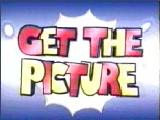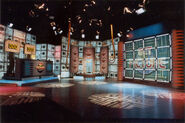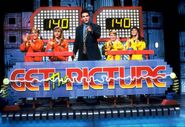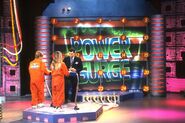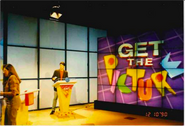| Host | |
| Mike O'Malley | |
| Announcer | |
| Henry J. Waleczko | |
| Broadcast | |
| Nickelodeon (Daily): 3/18/1991 – 12/6/1991 (Reruns until 3/13/1993)Nickelodeon/Nickelodeon UK (Simulcast Special): 9/1/1993 | |
| Packager | |
| MTV Networks | |
Get the Picture was a game show on Nickelodeon where two teams of two kids dressed in jumpsuits (one was the orange team, and the other was the yellow team) had to identify a hidden picture on a 16 screen video wall, either by choosing panels or connecting lines around a square. This was Mike O'Malley's first game show for Nickelodeon, airing from March 18, 1991 to December 6, 1991; before teaming up with Moira Quirk to work on another game show Nickelodeon GUTS in 1992; which later became Global GUTS during the 4th and final season in 1995, with reruns airing until March 13, 1993.
Gameplay[]
The gameplay described here. Changes are detailed in another subsection.
Main Game[]
Round 1: Connect the Dots[]
In the first season after the opening credits, announcer Henry J introduced Mike as he goofed around on his podium doing a different activity. In the second and final season after the opening credits, announcer Henry J introduced Mike as he makes his entrance and goes straight to his podium. Round 1 was called "Connect the Dots.” In that Round, dots outlined of a Thing, Things, Food, Animal, Character, Proper Name, and Monument was shown on the 16-panel screen with only the unconnected dots, the numbers of the sections, and the category showing. The host would ask a series of questions to both teams worth $20. They could buzz-in in the middle of reading of a question, and if the team answered the question correctly, they scored $20 and they got to pick a square. If incorrect, the opposing team would have a chance to answer once the host re-read the question. The square that they chose had the dots connected, after which the team could guess the picture. A correct guess awarded the team $50, but a team lost $20 for an incorrect guess.
Hidden in two of the squares were "Power Surges" which were picture guessing games worth $20, which revealed actual portions of the image; however, if the team failed, the money was awarded to the opposing team. The round continued until time was called, at which point the picture (if one was being played) would be revealed one square at a time. The first team to buzz in with the correct answer got the $50 for solving it. The teams did not lose any money if they guessed incorrectly and could guess as often as they wanted.
Round 2: Dots[]
In Round 2, which was called "Dots.” The board was broken up into squares with four points on them and a new subject was revealed. The categories were the same as in "Connect the Dots," but there were additional categories that were featured such as Person, People, Game, Sport, Place, Action, and Event. The puzzle was hidden behind the "Get the Picture" logo. The host would read a series of questions with multiple answers, and any team that gave all answers earned $40. If a team missed any part of the answer, the opposing team could give the remaining answers and steal the money once the host re-read the question. The team that earned the money selected two dots to connect for every answer the question had. If the lines made formed a box, that portion of the picture was revealed. In this round, correctly guessing the picture scored $75, while incorrect guesses still cost $20.
There was one "Power Surge" hidden on the board in Season 1, however, it was now a physical activity. Completing a Power Surge in this round earned the team $40, however, failure awarded the other team $40. Again, if time was running short the puzzle in play would be revealed one square at a time until someone guessed correctly for $75. After time ran out, the team with the most money won the game; if the game ended in a tie, one final picture was played under the same speed-up round perimeters with the first team to guess it right earning the extra $75 and the game. The winning team advanced to the "Mega Memory" bonus round.
Power Surges[]
Knowledge Activities[]
- Airport Security – The team would be shown some items as if they were being put through an airport security X-ray machine, and would have a 30 seconds to identify certain items that passed through. In the first season, they had to identify twelve total items, while in the second season, they had to identify eight items that start with a specific letter.
- Slap Happy (Season 2 Only) – A picture would slowly be revealed on the screen through hands "slapping" it onto the screen. The team had to identify five pictures in 30 seconds.
- Rebus Mania – The team would be shown a rebus and would have 20 or 30 seconds to solve it. Such rebuses included "Super Mario Bros." and "Marge and Homer Simpson".
- What's In Common? – Played similar to Rebus Mania, four pictures were shown, and the team had 30 seconds to identify what they had in common.
- It's Raining Pictures – Like it's raining, a picture was revealed one square down; the team had 30 seconds to identify five pictures.
- Follow that Rhyme – Like Simon, three pictures were shown; one at a time, a picture would reveal itself, and then the team had to repeat what they saw, until they got eight times in a row, alternating turns each time.
- Clue Me In – As in Pyramid and Password, one member gave a one-word clue for the other to guess. The team had 30 seconds to get three items.
- Find the Chiphead – Like Where's Waldo, the team was shown a picture. Using a telestrator called the "Videowriter", the team had to circle eight people with chip-type heads in 30 seconds.
- Down in Front (Season 2 Only) – People danced in front of music videos and the team had to identify the artists in them. Sometimes they had to identify just one within 20 seconds; other times, they had to identify three in 30 seconds.
- Data Distortion – Pictures were twisted and distorted. The team had to identify five within 30 seconds. Some second season episodes changed this to four in 30 seconds, or four in 45 seconds (depending on the episode).
- (You) Draw It – One contestant drew a picture on the Videowriter, while their teammate remained at the podium and tried to guess what was being drawn in 30 seconds. A second season variant had the roles switched, with one of the partners explaining how to draw the picture, and the other partner trying to guess what he/she was drawing (sometimes after time ran out).
- Don't Be So Negative – The team was shown negatives and had to identify what they were in 30 seconds. In the first season, they were of things, and they had to identify all five of them; in the second season, they were of celebrities, and they had to identify four out of five of them.
- Don't Stay Out in the Sun Too Long – Played similar to Don't Be So Negative, the team was shown images that were "solarized" by the sun, and they had to guess five of them within 30 seconds.
- Rear Window – Contestants looked out the rear-window of moving binoculars. The team had to identify five pictures within 15 seconds. In the second season, the time limit was changed to 20 seconds.
- Mike's Photo Album (Season 2 Only) – The team was shown pictures of world landmarks with something/someone blocking them (usually Mike's traveling companion Scooter Fishman) and they had to identify five of them in 30 seconds.
- Matchmaker (Season 2 Only) – The team was shown sixteen different images and they had 45 seconds to find the ones that go together.
- Mike's Maze (Season 2 Only) – Using the Videowriter, contestants had 45 seconds to navigate through a maze.
- Seeing Double (Season 2 Only) – Played similar to Matchmaker, the team was shown eight pairs of an image, with each pair slightly altered, and they had 45 seconds to match all the pairs.
- Off the Charts – The team was given a word search puzzle resembling an eye chart, and they had to find four words with a common theme in 30 seconds, with clues placed around the puzzle for assistance.
- Kiss my Picture (Season 2 Only) – Played similar to Slap Happy, lips would kiss the picture, with each lip revealing a photograph of a celebrity. The team had to identify three celebrities within 30 seconds.
- Splatter it On (Season 2 Only) – Portions of the picture were "splattered" onto the screen. Teams had to identify four out of five pictures in 30 seconds.
- Scrambled Pictures (Season 2 Only) – A cartoon was out of place, and the team had to identify it in 15 seconds.
- Extreme Close-Up (Season 2 Only) – A camera would show an object very close-up and slowly zoom out to show the entire item. The team had to guess three objects in 30 seconds.
- Computer Printout – A picture was revealed by "printing" (beginning in top like a computer). The team had to identify five pictures in 30 seconds.
- You Can Count On It (Season 2 Only) – Math problems were asked, and players had to guess what number (from 1 to 16) was the answer to the problem. Each correct answer removed that number, revealing a piece of a picture. After 30 seconds, the teams had to guess what the picture on the screen was.
- Word Up (Season 2 Only) – A word search puzzle appeared on the Videowriter. One contestant circled as many hidden words as they could in 30 seconds while the teammate helped find words. When time ran out, they took a guess as to what theme the words fit.
- Mike's Makeover (Season 2 Only) – Played similar to (You) Draw It, a picture of Mike would appear on the Videowriter. One player drew the clue that was on the card (this clue was always shown to the home audience), and the partner had to identify it in 20 seconds.
- Filler-Up Irregular – A video of an object being covered in a substance was shown in reverse. The team had 15 seconds to identify the object.
- Digitized Display – Pixelated pictures would slowly come into focus, and the team had to identify five of them in 30 seconds.
- Buried with the Mummy (Season 2 Only) – The team was shown objects wrapped in bandages that were next to the wallpaper with the same design, and had to identify five of them in 30 seconds.
- This End Up – Pictures were shown upside down, right side up, or sideways, and the team had to identify five pictures within 15 seconds.
- Name That Theme – Pictures were hidden on the video wall that related to a particular theme. The team had to identify four hidden pictures in 30 seconds. In the second season, this was changed to identifying sixteen hidden pictures in 30 seconds.
- Falling Leaves (Season 2 Only) – Just like autumn, leaves would fall into place that formed a picture. The team had to identify three pictures in 30 seconds.
- Wrap It (Season 2 Only) – Played similar to Buried with the Mummy, objects were wrapped in a pattern, which was the same as the background. The team had to identify four out of five objects in 30 seconds.
- Hidden Pictures (Season 2 Only) – Using the Videowriter, the team had 30 seconds to circle five hidden pictures that were concealed in the picture.
- To Half or Half Not (Season 2 Only) – Pictures of famous celebrities had their faces mirrored, and the team had to identify three out of five of them in 30 seconds.
- Scrambled Faces (Season 2 Only) – The team was shown four pictures of celebrities, each cut into four squares, and they had to identify all four of them in 30 seconds.
- Find it in a Crowd (Season 2 Only) – Played similar to Find the Chiphead, the team was shown a wearable object on the Videowriter, and then a picture of an audience. They had 15 seconds to find the five audience members wearing it.
Physical Activities (Season 1 Only)[]
All physical Power Surges, except one, involved players performing tasks in order to reveal pieces to a picture. After the team completed the Power Surge, they were given one chance to guess what the picture was for $40, failure to do so earned $40 for the opposing team. The games continued until all nine numbers were revealed, time ran out, or a team ran out of objects.
- Toss Across – Played similar to the Tyco game of the same name. The team playing had 30 seconds to toss computer chips in an attempt to flip over the nine game pieces. The pieces were three-sided and had numbers, punctuation marks, and the Get the Picture logo on them, with the object being to reveal the numbers. The first few times this was played, two of the sides had numbers. Presumably to avoid having all the numbers being revealed early, this was quickly changed to only one side having numbers and the other having punctuation marks. The Get the Picture logo side remained intact.
- Ring Toss for Pieces – Same idea as Toss Across, with the exception of the team having to throw rings over spots on a computer motherboard. The spots were not all in order, however.
- Putting for Pieces – Similar to mini golf, with nine holes to putt into.
- Shuffling for Pieces – Similar to shuffleboard, with the exception of the team shuffling large floppy disks, trying to get the center of the disk onto designated spots, in numerical order from top to bottom. This game and the ring toss game used a larger grid than the Toss Across and mini golf games.
- Jigsaw Puzzle – The team had 45 seconds to put a jigsaw puzzle together, retrieving the pieces from a podium and placing them on a giant jigsaw puzzle board. When time ran out, or if the puzzle had been completed, the contestants had to guess what the picture formed by the puzzle was.
Mega Memory (Bonus Round)[]
Nine numbered pictures were shown to the team for ten seconds, then they were concealed. The team stood in front of a large keypad numbered 1 through 9, each button corresponding to one of the pictures. O'Malley read a clue corresponding to one of the nine hidden pictures. Taking turns, the contestants pressed the number of the matching picture. For each correct answer within 45 seconds, the team won cash or a prize. The team split $200 a picture for identifying the first six; two prizes of increasing value for the next two, and a trip for all nine. They did occasionally deviate from offering a trip as the grand prize, merchandise prizes such as a new computer, a new TV/VCR combo, or a camcorder were sometimes seen.
Season 2 Changes[]
- Contestants now wore nametags.
- The contestant podium replaced its computer-keyboard buzzers with blue plunger buzzers.
- The teams played for points, though all numerical values remained the same.
- The game started out with an opening picture revealed one square at a time with a correct guess earning 20 points.
- In Mega Memory, the time limit decreased to 35 seconds, winning teams split $100 for each of the first six Mega Memory pictures identified, and the "take turns" rule was enforced.
- All Power Surges were knowledge-based, with an additional Power Surge added in Round 2, and they all took place at center stage. Because of this, a special "Power Surge" area was added and placed in front of the video wall. There was also a piece containing the "Video Writer.”
- Mike O'Malley's question cards were bigger than they were in Season 1.
- The contestant podium was redesigned. Season 1 just had a small Get the Picture logo at the center of the front. The Season 2 design had a massive logo that took up the entire front.
- The "connect the dots" intro was removed in lieu of a glance at the initial toss-up puzzle.
- It was more common to show a screen shot of a "completed" puzzle following its completion, even if the audience had already seen it completed.
- Mike was noticeably more excited and loud when announcing a Power Surge.
| This page uses Creative Commons Licensed content from Wikipedia (view authors). |
Gallery[]
Stage Assistants (Season 2)[]
Craig Hibbard
Tony Ivory
International versions[]
- The United Kingdom had its own version on Nickelodeon UK and hosted by Peter Simon.
- The Netherlands has its version called Snap Het on Nickelodeon Netherlands.
Rating[]
Music[]
Dan Vitco
Inventor[]
Marjorie Cohn
Additional Pages[]
Links[]
The Get the Picture Webstation
Jay Anton's Rules for Get the Picture
Get the Picture Rules @ Loogslair.net


